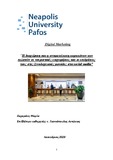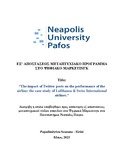Ανάλυση και αξιολόγηση της πρότασης της Ευρωπαϊκής Επιτροπής «EU Customs Reform» για την τελωνειακή μεταρρύθμιση
ENGLISH ABSTRACT: In the document "Political guidelines for the next European Commission 2019-2024" which describes the vision of Commission President Ursula von der Leyen, it becomes clear how important the reform of the customs union and its transition to the next stage is for the entire EU. The main scope of the thesis is to analyze the Commission's proposal entitled "EU Customs Reform" which includes the establishment of a new Union Customs Code and the EU Customs Authority, and to assess whether it is an appropriate strategy and tool that will contribute to the further development of the customs union and will be an important step towards its integration, while satisfying the objectives of the President of the Commission. The analysis and assessment of the proposal was done through the study, analysis, evaluation and comparison of primary sources and using a two-tier evaluation framework proposed by the author. The first level concerns the two principles that govern the operation of the customs authorities and determine the level of their operation, the Principle of Service and the Principle of the Security (including both the term safety and security). And the other level concerns three dimensions that determine the level of operation of the customs union and it was assessed whether these are satisfied with the proposed changes and are a) the effective management and analysis of risks, b) the uniformity in the conduct of controls and c) the uniformity of operation of the customs authorities. These three dimensions are parallel and individual characteristics of the two principles above. From the analysis and assessment using the proposed evaluation framework, it emerged that the proposed proposal if adopted in its entirety with minimal amendments will satisfy the objectives set by the European Commission and its president and at the same time will be a step towards the development of the European customs union and its integration. Also identified points where the proposal was conservative while it could introduce groundbreaking reforms and get even closer to the goal and perhaps achieve much better results. It is possible that the fear of Member States' backlash to agreeing and implementing the specific arrangements led the Commission to adopt a more restrained stance on the proposed reforms. Finally, points were identified in the proposal that need attention and modification because they can be a brake and create problems during the implementation of the new UCC without yielding the expected benefits. For this reason, some suggestions were made that could contribute and make amends or improve some of its points.
Στο κείμενο «Πολιτικές κατευθύνσεις για την επόμενη Ευρωπαϊκή Επιτροπή 2019-2024» όπου περιγράφεται το όραμα της προέδρου της Ευρωπαϊκής Επιτροπής Ούρσουλα φον ντερ Λάιεν γίνεται σαφές το πόσο σημαντική είναι η μεταρρύθμιση της τελωνειακής ένωσης και η μετάβασή της στο επόμενο στάδιο για την Ευρωπαϊκή Ένωση συνολικά. Κύριος στόχος της διπλωματικής εργασίας είναι α) να αναλύσει την πρόταση της Ευρωπαϊκής Επιτροπής με τίτλο «EU Customs Reform» που περιλαμβάνει την θέσπιση ενός νέου Ενωσιακού Τελωνειακού Κώδικα και την ίδρυση της Τελωνειακής Αρχής της ΕΕ και β) να αξιολογήσει αν αποτελεί την κατάλληλη στρατηγική και εργαλείο που θα συμβάλει στην περαιτέρω εξέλιξη της τελωνειακής ένωσης και σημαντικό βήμα για την ολοκλήρωσή της ικανοποιώντας παράλληλα τους στόχους της Προέδρου της Ευρωπαϊκής Επιτροπής. Η ανάλυση και η αξιολόγηση της πρότασης πραγματοποιείται μέσω της μελέτης, ανάλυσης, αξιολόγησης και σύγκρισης πρωτογενών πηγών και με την χρήση ενός προτεινόμενου από τον συγγραφέα πλαισίου αξιολόγησης δύο επιπέδων. Το ένα επίπεδο αφορά τις δύο αρχές που διέπουν την λειτουργία των τελωνειακών αρχών και καθορίζουν το επίπεδο της λειτουργίας τους, την Αρχή της Εξυπηρέτησης και την Αρχή της Προστασίας (περιλαμβάνεται τόσο ο όρος ασφάλεια όσο και προστασία, safety and security). Και το άλλο επίπεδο αφορά τρείς διαστάσεις που καθορίζουν το επίπεδο λειτουργίας της τελωνειακής ένωσης και αξιολογείται κατά πόσο αυτές ικανοποιούνται με τις προτεινόμενες αλλαγές. Αυτές είναι α) η αποτελεσματική διαχείριση και ανάλυση κινδύνων, β) η ομοιομορφία στην διενέργεια των ελέγχων και γ) η ομοιομορφία της λειτουργίας των τελωνειακών αρχών. Οι τρείς αυτές διαστάσεις αποτελούν παράλληλα και επί μέρους χαρακτηριστικά των δύο ως άνω αρχών. Από την ανωτέρω ανάλυση και αξιολόγηση προκύπτει πως η προτεινόμενη πρόταση, υιοθετούμενη στο σύνολο της με ελάχιστες τροποποιήσεις δύναται να ικανοποιήσει τους στόχους που έχουν τεθεί από την Ευρωπαϊκή Επιτροπή και την Πρόεδρό της και παράλληλα να αποτελέσει ένα βήμα προς την εξέλιξη της ευρωπαϊκής τελωνειακής ένωσης και την ολοκλήρωση της. Εντοπίζονται και σημεία στα οποία η πρόταση είναι συντηρητική ενώ θα μπορούσε να εισάγει ρηξικέλευθες μεταρρυθμίσεις και να πλησιάσει ακόμη περισσότερο τον στόχο και να επιτύχει ίσως και πολύ καλύτερα αποτελέσματα. Πιθανόν ο φόβος της αντίδρασης των κρατών μελών απέναντι στην εφαρμογή των συγκεκριμένων ρυθμίσεων να οδήγησε την Επιτροπή στην υιοθέτηση μιας πιο συγκρατημένης στάσης. Τέλος εντοπίζονται και σημεία στην πρόταση, τα οποία χρήζουν προσοχής και τροποποιήσεων, διότι μπορεί να αποτελέσουν τροχοπέδη και να δημιουργήσουν προβλήματα κατά την εφαρμογή του νέου ΕΤΚ αποτρέποντας τα προσδοκόμενα οφέλη. Για αυτό το λόγο προτείνονται τροποποιήσεις που θα μπορούσαν να συμβάλουν και να διορθώσουν ή να βελτιώσουν κάποια σημεία του.



